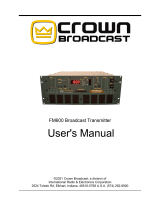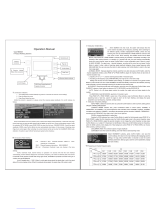
RFBA User Manual Chrisso Technologies, LLC Page 6
Triple Tuner Modulation Analyzer
The RFBA is capable of monitoring over 20 FM signal parameters as well as RDS data for each tuner
simultaneously. The end user may wish to monitor several of their own stations to assure proper
functionality or they may wish to monitor adjacent channels that sometimes over-modulate. The RFBA
can also be controlled via the Ethernet connection, allowing a remote user to switch between stations
that are being monitored. For operation in this configuration, the only connections required are the RF
antennas and, if remote monitoring is desired, Ethernet. All of the parameters are available via the
display menu or via the Ethernet connection. Note: the modulation analyzer feature is only available on
the RFBA-1MA or as an upgrade to the RFBA-1. All units are capable of performing modulation analyzer
functionality. If your RFBA does not include this function, please contact Crown Broadcast for sales
information.
Standalone FM Translator with RDS Encoding
The RFBA uses a Digital Signal Processor, or DSP, to reconstruct an FM Stereo Composite Signal. In
addition to the typical composite signal, the RFBA can also add RDS data to the composite signal. The
audio source for this configuration is only available from the main tuner (Tuner #1). Tuner #2 and Tuner
#3 do not include capability for composite signal regeneration, but can still be used for signal reception
or analyzing.
The FM Stereo Composite Signal is always available from Tuner #1. In contrast to older translator
designs, the RFBA does not simply pass through a down-converted FM multiplex. Instead, the audio and
RDS data are recovered using world-class automotive-grade reception algorithms customized by Chrisso
Technologies for translator purposes. A new FM multiplex with optional RDS data is then created
digitally. The composite output signal is available on the BNC connector on the rear of the product, and
can be fed to the composite input of your RF modulator/transmitter. The user can digitally adjust the
MPX output level, pilot percentage, RDS modulation level, and many RDS parameters. Your RFBA will
automatically adjust the audio portions of the FM Multiplex to account for user adjustments of the Pilot
level and of the RDS level, ensuring strict adherence to the composite level specifications of the FCC.
The user can program many of the RDS parameters to be passed through from the received signal or to
be user defined, allowing for certain data to be unique to your translator location. Program
Identification (PID) is an example of an RDS parameter that the end user may wish to program
differently, while leaving Program Service Name (PSName) and other fields unmodified.
Stand-alone Automatic Stereo Separation (SASS)
The FM translator also includes a new function to align the composite output with a specific RF
modulator. Many RF modulators include a filter on the MPX input. This filter can cause a small shift in
the L-R component of the composite signal and will degrade the maximum stereo separation. The RFBA
includes an alignment routine where the RFBA can adjust the L-R for your specific RF modulator thus
optimizing the maximum separation. Please see the alignment section of this manual for further details.

































